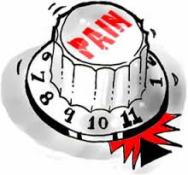That’s the thing about pain, it demands to be felt.
Perception: the organization, identification, and interpretation of sensory information in order to represent and understand the environment.
For just a moment, imagine three young friends on the school playground having an in-depth conversation about the color purple. One of the adolescents was born blind and the other two are trying to describe what the color looks like to an individual who has never seen a flower, an eggplant, a crayon, or even a sunset. Imagine that of the two friends with sight, one sees the color purple and is reminded of a big silly dinosaur they grew up watching on TV and the other simply recalls the fresh grapes they ate last summer on a relative’s vineyard. Both are picturing the color purple and both are correct, but they have two very different perceptions of what purple appears to be, based on the input of their other senses. How can these friends describe a sensation or feeling to their blind friend? What does purple feel like or taste like?
This is how I imagine the various types and levels of pain between different individuals – as diverse as the assorted colors in the rainbow, yet just as difficult to put into words.
 In these modern times, we are lucky to have other ways of communicating the things we
In these modern times, we are lucky to have other ways of communicating the things we
cannot put into words. And, in our purportedly evolving society, communication methods and messages continue to get shorter and shorter until we merely point to or click on a picture in lieu of actual words. Rather than worry about pesky things like grammar and spelling and vocabulary, we now have EMOJIs ?. I can appreciate an appropriately timed and clever emoji as much as the next person (in fact, I once attempted to translate the lyrics to an entire song into emojis while waiting at the doctor’s office – just for the hell of it), but I have to say that I don’t believe these engaging little graphics are as “new” as our teenage counterparts would have us believe.
Those of us who have serious medical issues or chronic pain have been communicating via a version of emojis for ages. Of course, I’m talking about the smiley face pain scale (AKA Wong-Baker Pain Scale) that you’ll find see in nearly any doctor’s office. Because pain CAN be very difficult to explain, I can also see why this Wong-Baker person(s) created the scale as a simpler way to communicate a non-tangible feeling in a more universal manner.
But, is it really universal and as un-ambiguous as it seems? Personally, I find the tool to be vague and open to interpretation and frankly, those stupid little grimacing faces just irritate me.
First of all, I believe pain is relative. Our thresholds for the level of pain we are able to bear vary across the board. I recently went to the doctor for an earache and when she asked me the inevitable current level of pain question, I hesitated. How do I answer that? It WAS painful and uncomfortable, bu t after having a kidney transplant… well, it just didn’t seem as significant in comparison.
t after having a kidney transplant… well, it just didn’t seem as significant in comparison.
In the world many of us relate to, where our very existence is trademarked by multiple needle sticks, gigantic horse pills, surgeries, lumbar punctures, biopsies and other various forms of painful torture, how can my judgement of pain be accurate or, at the very least, relevant to the random person standing next to me whose never had so much as a stubbed toe? I just don’t know how to answer this question on a basic level, when my world is often defined by various pains and my perception of pain is likely very different from someone else’s.
 Secondly, although improving somewhat in recent years, in general, chronic pain is widely misunderstood and often misinterpreted. Additionally, our society infers that admitting to pain implies weakness – a trait that I certainly wouldn’t use to describe any of the chronic illness warriors I know. Finally, an uptick in opium-dependency and subsequent legal and societal scrutiny has made doctors much more cautious than they used to be when diagnosing and addressing complaints of pain. In general, this is good for cracking down on pill-seekers and drug addicts, but bad for those who rely on these very medications daily in order to live a normal life and must jump through hoops to get them. Overall, because pain is not visible or easy to explain, it cannot be simply x-rayed or evaluated through blood tests and therefore, it has consequently become harder and harder to justify and manage pain relief.
Secondly, although improving somewhat in recent years, in general, chronic pain is widely misunderstood and often misinterpreted. Additionally, our society infers that admitting to pain implies weakness – a trait that I certainly wouldn’t use to describe any of the chronic illness warriors I know. Finally, an uptick in opium-dependency and subsequent legal and societal scrutiny has made doctors much more cautious than they used to be when diagnosing and addressing complaints of pain. In general, this is good for cracking down on pill-seekers and drug addicts, but bad for those who rely on these very medications daily in order to live a normal life and must jump through hoops to get them. Overall, because pain is not visible or easy to explain, it cannot be simply x-rayed or evaluated through blood tests and therefore, it has consequently become harder and harder to justify and manage pain relief.
In my experience, the pain scale in its current state, is becoming more and more obsolete and unreliable. In answer, I’ve taken it upon myself to propose some minor improvements to the current Wong-Baker pain scale to make it more relatable and applicable to everyday situations. Please enjoy my “new and improved” pain scale and let me know if you agree in the comments! ?

Ok, this was just funny
Love it – great job!